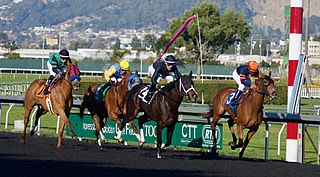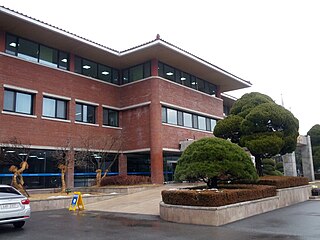
Thoroughbred racing is a sport and industry involving the racing of Thoroughbred horses. It is governed by different national bodies. There are two forms of the sport – flat racing and jump racing, the latter known as National Hunt racing in the UK and steeplechasing in the US. Jump racing can be further divided into hurdling and steeplechasing.

Horse racing is an equestrian performance sport, typically involving two or more horses ridden by jockeys over a set distance for competition. It is one of the most ancient of all sports, as its basic premise – to identify which of two or more horses is the fastest over a set course or distance – has been mostly unchanged since at least classical antiquity.

Gyeonggi-do is the most populous province in South Korea. Its name, Gyeonggi, means "京 and 畿 ". Thus, Gyeonggi-do can be translated as "Seoul and the surrounding areas of Seoul". Seoul, the nation's largest city and capital, is in the heart of the area but has been separately administered as a provincial-level special city since 1946. Incheon, the nation's third-largest city, is on the coast of the province and has been similarly administered as a provincial-level metropolitan city since 1981. The three jurisdictions are collectively referred to as Sudogwon and cover 11,730 km2 (4,530 sq mi), with a combined population of over 26 million - amounting to over half (50.25%) of the entire population of South Korea at the 2020 Census.
The Breeders' Cup Filly & Mare Turf is a Weight for Age Thoroughbred horse race on turf for fillies and mares, three years old and up. It is held annually at a different racetrack in the United States as part of the Breeders' Cup World Championships.

Gwacheon is a city in Gyeonggi Province, South Korea. It lies close to Seoul in the heart of the Seoul National Capital Area, and also lies just east of Anyang. Seoul Subway Line 4 passes through the city.
Hawthorne Race Course is a racetrack for horse racing in Stickney/Cicero, Illinois, near Chicago.
The Withers Stakes is a Grade III American Thoroughbred horse race for three years old horses over the distance of 1+1⁄8 miles on the dirt scheduled annually in February at Aqueduct Racetrack in Queens, New York. The event currently carries a purse of $250,000.
The Breeders' Cup Juvenile Turf is an American Thoroughbred horse race for two-year-old horses, run on a grass course at a distance of one mile. It is part of the Breeders' Cup World Championships, the de facto year-end championship for North American thoroughbred racing. All Breeders' Cups to date have been conducted in the United States, with the exception of the 1996 event in Canada.

Urban Sea was an American bred Thoroughbred racemare best known for winning France's most prestigious race, the Prix de l'Arc de Triomphe, in 1993 and for her importance as a world-class broodmare. She is one of ten mares to produce two Derby winners, namely Galileo and Sea the Stars. She is the only mare in the 21st century to produce two Derby winners. None has produced three winners of this race.
The Breeders' Cup Turf Sprint is a Weight for Age stakes race for thoroughbred racehorses three years old and up. As its name implies, it is a part of the Breeders' Cup World Championships, the de facto year-end championship for North American thoroughbred racing. The distance of the race will vary depending on the host track's turf course requirements.
The Breeders' Cup Juvenile Fillies Turf is a one-mile turf stakes race for thoroughbred fillies two years old. As its name implies, it is part of the Breeders' Cup World Championships, the de facto year-end championship for North American thoroughbred racing.
Regal Intention (1985–2008) is a Canadian Champion Thoroughbred racehorse.

Keiba; Horse racing in Japan is a popular equestrian sport, with more than 21,000 horse races held each year. There are three types of racing that take place in Japan - flat racing, jump racing, and Ban'ei Racing.
Samuel Anthony Boulmetis Sr. was an American thoroughbred horse racing jockey who was inducted into the National Museum of Racing and Hall of Fame in 1973. The Hall's induction biography says that "His peers described him as an honest and intelligent rider, qualities he later demonstrated as a racing official and state steward for New Jersey."
LetsRun Park Busan–Gyeongnam, also known as Busan–Gyeongnam Horse Racing Park is the largest hippodrome in Gimhae and Busan, South Korea. It opened in 2005 and is operated by Korea Racing Authority (KRA).
Horse racing in the United States dates back to 1665, which saw the establishment of the Newmarket course in Salisbury, New York, a section of what is now known as the Hempstead Plains of Long Island, New York. This first racing meet in North America was supervised by New York's colonial governor, Richard Nicolls. The area is now occupied by the present Nassau County, New York, region of Greater Westbury and East Garden City.
Horse racing in South Korea traces back to May 1898, when a foreign language institute run by the government included a donkey race in its athletic rally. However, this type of racing was sponsored for entertainment purposes only. No betting was conducted. It was in the 1920s that 'modern' horse racing involving a betting system made its debut. In 1922, the Chosun Racing Club, the nation's first-ever authorized horse racing club, was established to make horse racing more systematic and better organized. In 1923, the pari-mutuel betting system was officially adopted for the first time in Korea. The Sinseol-dong racecourse opened in 1928 and incorporated racing clubs were allowed to have their own racecourses.

Korea Racing Authority is a public company established to manage the racehorse breeding industry in South Korea.
The Breeders' Cup Juvenile Turf Sprint is an American Thoroughbred horse race for two-year-old horses, run on a grass course at a distance of 5 or 5+1⁄2 furlongs, depending on the configuration of the host track. It is part of the Breeders' Cup World Championships, the de facto year-end championship for North American thoroughbred racing. All Breeders' Cups to date have been conducted in the United States, with the exception of the 1996 event in Canada.










